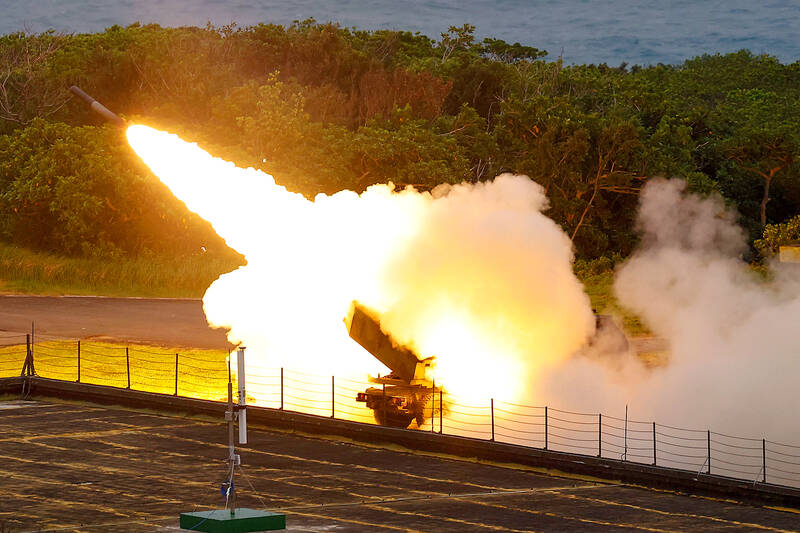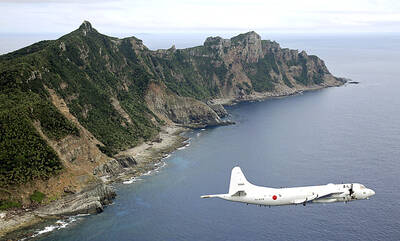The military yesterday conducted its first live-firing of High Mobility Artillery Rocket Systems (HIMARS) purchased from the US, as the nation upgrades its capabilities to repel a potential Chinese attack.
The US is Taiwan’s most important arms supplier, despite the lack of formal diplomatic ties.
Taiwan has faced increased military pressure from China, including several rounds of war games, as Beijing seeks to assert its sovereignty claims over the nation.

Photo: Ann Wang, Reuters
Taiwan has bought 29 of Lockheed Martin’s HIMARS, with the first batch of 11 received last year and the rest set to arrive by next year.
The truck-mounted units can launch multiple precision-guided rockets and have been used by Ukraine against Russia in their ongoing conflict.
With a range of about 300km, they could hit coastal targets in China’s Fujian Province, on the other side of the Taiwan Strait, in the event of a conflict.
Reporters watched yesterday as the army launched rockets from the HIMARS at Jiupeng base in Pingtung County.
Colonel Ho Chih-chung (何至中) told reporters that US technical personnel were present during the live-fire drill and helped to resolve a “signal error” during the first round when three launchers failed to fire simultaneously.
“We believe this exercise provides an opportunity to enhance our troubleshooting capabilities, allowing us to better demonstrate realistic combat readiness in the event of war,” Ho said.
Chinese-language Asia-Pacific Defense magazine editor-in-chief Cheng Chi-wen (鄭繼文), a military expert who attended the drill, said that HIMARS has gained international prestige during the Russia-Ukraine war.
Its overall performance is better than the locally made Thunderbolt-2000 multiple launch rocket system, as the GPS-aided navigation system provides HIMARS with powerful and precise attack capabilities, he said.
Given the HIMARS’ superior performance, the Chungshan Institute of Science and Technology would be advised to unify its ammunition with that of the Thunderbolt-2000, Cheng said.
It would help the army map out a stronger asymmetric warfare strategy, if HIMARS’ GPS-aided navigation technology can be applied to locally made weapons’ fire control systems to facilitate information sharing between both systems, he said.
Yesterday’s test came a day after Taiwan said it had detected another “joint combat readiness patrol” by China’s military near Taiwan involving warplanes and warships.
Additional reporting by Chen Chih-cheng

MISINFORMATION: The generated content tends to adopt China’s official stance, such as ‘Taiwan is currently governed by the Chinese central government,’ the NSB said Five China-developed artificial intelligence (AI) language models exhibit cybersecurity risks and content biases, an inspection conducted by the National Security Bureau (NSB) showed. The five AI tools are: DeepSeek, Doubao (豆包), Yiyan (文心一言), Tongyi (通義千問) and Yuanbao (騰訊元寶), the bureau said, advising people to remain vigilant to protect personal data privacy and corporate business secrets. The NSB said it, in accordance with the National Intelligence Services Act (國家情報工作法), has reviewed international cybersecurity reports and intelligence, and coordinated with the Ministry of Justice Investigation Bureau and the National Police Agency’s Criminal Investigation Bureau to conduct an inspection of China-made AI language

BOOST IN CONFIDENCE: The sale sends a clear message of support for Taiwan and dispels rumors that US President Donald Trump ‘sold out’ the nation, an expert said The US government on Thursday announced a possible sale to Taiwan of fighter jet parts, which was estimated to cost about US$330 million, in a move that an expert said “sends a clear message of support for Taiwan” amid fears that Washington might be wavering in its attitude toward Taipei. It was the first announcement of an arms sale to Taiwan since US President Donald Trump returned to the White House earlier this year. The proposed package includes non-standard components, spare and repair parts, consumables and accessories, as well repair and return support for the F-16, C-130 and Indigenous Defense Fighter aircraft,

CHECKING BOUNDARIES: China wants to disrupt solidarity among democracies and test their red lines, but it is instead pushing nations to become more united, an expert said The US Department of State on Friday expressed deep concern over a Chinese public security agency’s investigation into Legislator Puma Shen (沈伯洋) for “secession.” “China’s actions threaten free speech and erode norms that have underpinned the cross-strait ‘status quo’ for decades,” a US Department of State spokesperson said. The Chongqing Municipal Public Security Bureau late last month listed Shen as “wanted” and launched an investigation into alleged “secession-related” criminal activities, including his founding of the Kuma Academy, a civil defense organization that prepares people for an invasion by China. The spokesperson said that the US was “deeply concerned” about the bureau investigating Shen

DISPUTE: A Chinese official prompted a formal protest from Tokyo by saying that ‘the dirty head that sticks itself out must be cut off,’ after Takaichi’s Taiwan remarks Four armed China Coast Guard vessels yesterday morning sailed through disputed waters controlled by Japan, amid a diplomatic spat following Japanese Prime Minister Sanae Takaichi’s comments on Taiwan. The four ships sailed around the Senkaku Islands — known as the Diaoyutai Islands (釣魚台) to Taiwan, and which Taiwan and China also claim — on Saturday before entering Japanese waters yesterday and left, the Japan Coast Guard said. The China Coast Guard said in a statement that it carried out a “rights enforcement patrol” through the waters and that it was a lawful operation. As of the end of last month,